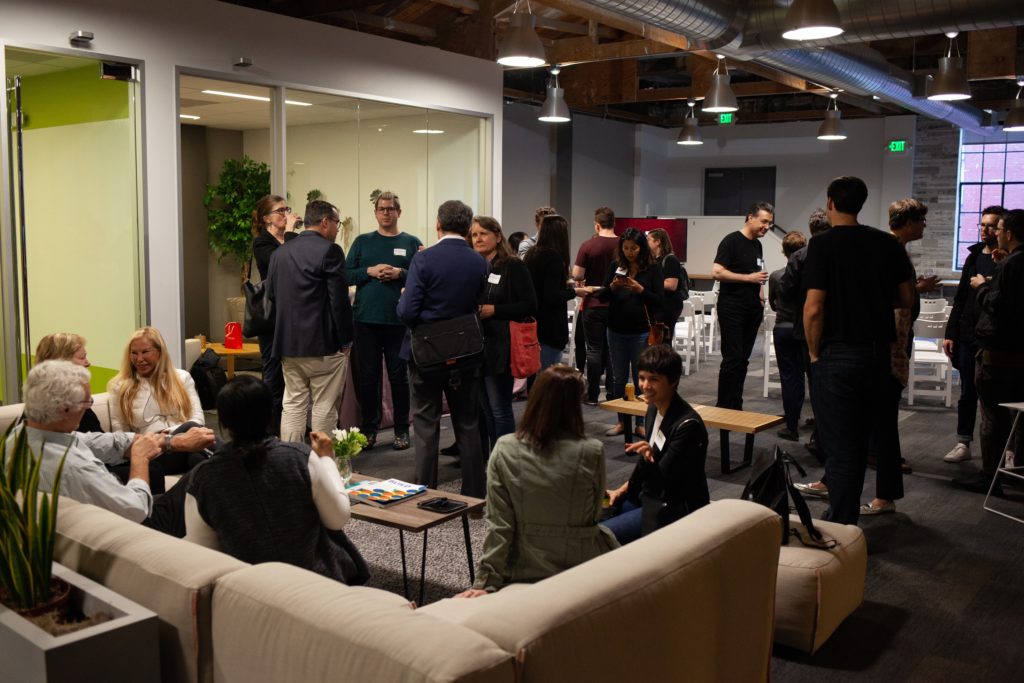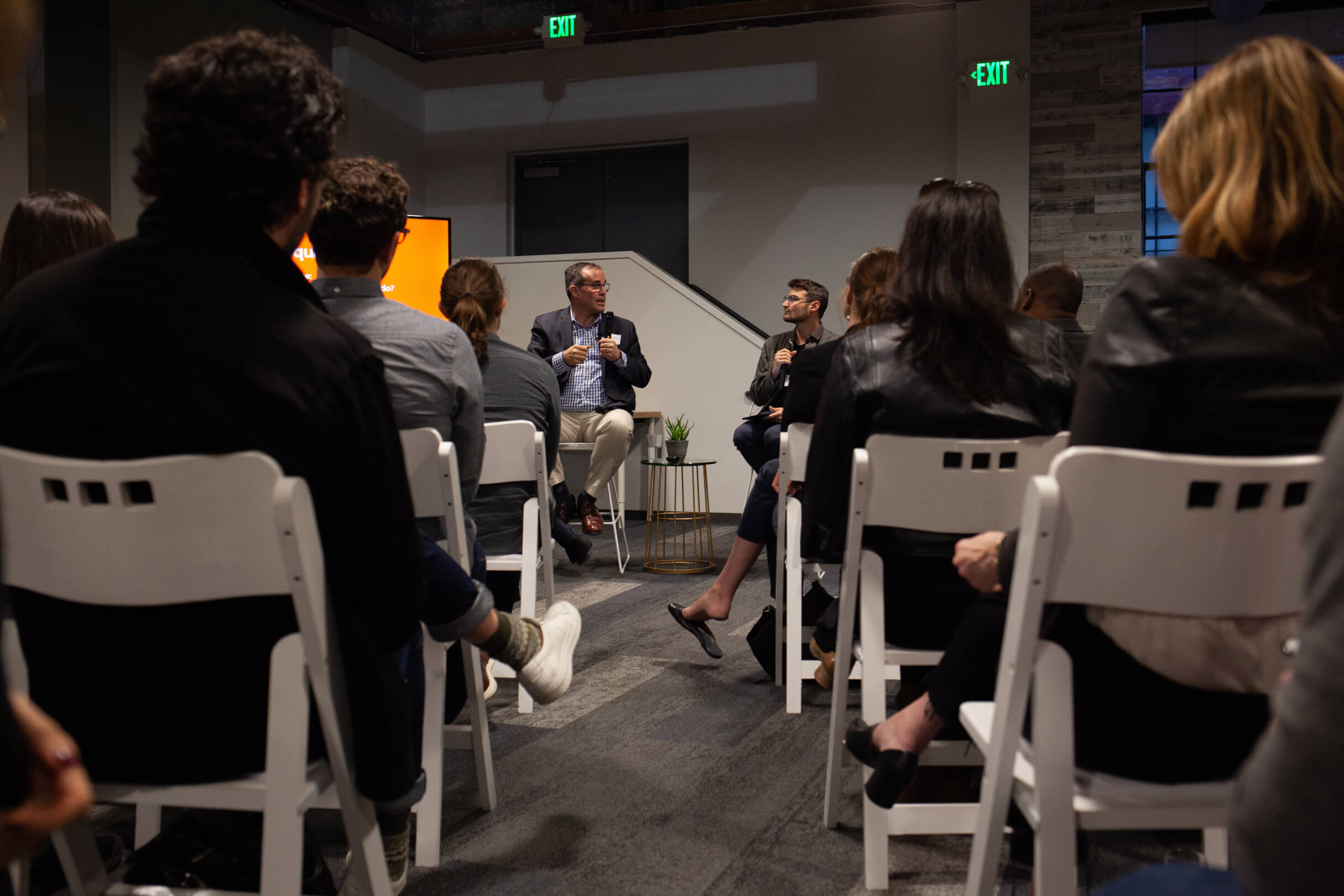This spring, Density hosted a special event with Patrick Larvie, who has lead research teams at Google, Yahoo! and ISER, Brazil’s largest NGO. The event, ‘Rewriting the Rules on Workplace Design,’ was attended by over 60+ Bay area residents from companies like Adobe, Genentech, Gensler and WeWork.
Architecture is this fantastically circular world. We know good architecture because architects tell us when we see it.
In a Q+A session, Patrick drew on his 15 years of experience leading international research teams and his current role as the lead of user experience team for the group within Google responsible for its workplace. The session was moderated by Ari Kepnes, Director of Market Research of Density. Both Ari and Patrick are alums of a small liberal arts school, Sarah Lawrence College. They explored how workplaces require a multi-disciplinary approach to architecture and design.
To learn more, watch the video or read the interview below:
What is it going to take for the status quo to change?
I think that asking vastly different questions and completely rethinking the way we approach design is a big part of it. It starts with three questions: “What do I need my workplace to do?” “How can I know good design from bad?” and “What can I do to improve what I have?” These questions are very unusual to the way design contracts are written today. Typically, discussions are broad and thematic, and might be limited to meeting the fire code. This requires a deeper understanding of what people are trying to do and how the environments they work in are helping or hindering that.

Don’t ask, ‘What do you want around your desk? What do you want in your conference room?’
Can you give me an example of how to get that data?
Don’t ask people what office they want, instead ask them about their most successful day. Ask them, “Can you tell me about a fantastic day when you were delighted to be at work? Tell me about that day from start to finish.” Listen to the qualities of that day and how you can apply them to the design of the environment. So, if I’m going to meet with a client, and I need to impress that client, then I need a place for the client to interact with the company. I probably want something that’s not just my desk.
Don’t ask, “What do you want around your desk? What do you want in your conference room?” Instead, ask “What do you do? Tell me about a day when you were really successful,” and then abstract what the space should be. Today we really do the opposite.
Different employees have different perspectives on their perfect day. How can spaces be useful to more people?
When design firms engage, they typically they talk to one person about how things should be. I wouldn’t be afraid to ask this question to more people: “What do you do? Tell me about a day when you were really successful?” Unless someone does something totally different in a given environment, it’s unlikely that you will hear an infinite versions of what a successful day is like. My experience is that there are relatively few types, and that most of them can be served with a few principles, which are not the principles that have been used in the past.

How do you know good design from bad?
Architecture is this fantastically circular world. We know good architecture because architects tell us when we see it. They give each other prizes. And one of my favorite genres of architecture failure is the airport.
One example of this is Terminal 4 in Madrid. It’s a beautiful, soaring building, with giant expanses of space and color.It takes 15 minutes to get from the city center to the airport, but it takes 35 minutes to get from the check-in counter to a gate. That’s a failure.
A successful airport is one where people get where they need to go. It shouldn’t take longer to get from the check-in counter to the gate than it takes to get from the center of the city to the airport. This is a terminal that won multiple prizes. It’s a beautiful airport, and you’ll experience that beauty because you’ll be lost. It’s very difficult to navigate. If I were the operator of that airport, I’d say, “you are not done until people can get to their gate in under 20 minutes.”
In the workplace, what is the criteria for success?
The trick is having clear criteria for filtering signal from noise. If my job requires extended periods of concentration and focus. I can’t achieve extended periods of concentration and focus, then that workplace has failed.
Ask them “What are you trying to do?” If what you’re trying to do is write a novel, and to write that you need absolute peace and quiet, I would say, “it seems like this environment is not set up for you.”
There’s no environment that people love all the time. But you can ask, “Is there some reasonable level that 85% of the time you get what you need done?” “How often do you have to move because the air conditioning is coming down on your head?” “How do you have to move people the people around you are too loud?” I’d get a little more fine-grained with my questions.
There’s the inability to learn. What if you didn’t disengage with a design firm the day you opened? What if you don’t cut the ribbon and cut ties?
I was shocked to hear about the lack of feedback between architects and the people who use buildings.
It’s absolutely shocking. It shouldn’t be the case. When we think about design and construction, one of the dirty secrets is that today it’s 50% less efficient than it was in 1968, and what drives that is constant customization and small scale projects. There’s the inability to learn. What if you didn’t disengage with a design firm the day you opened? What if you don’t cut the ribbon and cut ties? You could say, “I’d like you to run that building until people are able to do what they need to do?” There are lots of ways we could set requirements and say, “Here are some functional goals we’d really like to meet, in partnership.” That’s the way we close that feedback loop. Closing that loop is what keeps me employed. It’s the design gap that requires some research.

What about the rise of WeWork and the idea of shared spaces? I think that is one answer to what you’re describing, providing workplace as a service.
I admire WeWork. The idea of providing workplace as a service rather than a one-off project is a really interesting idea. I am fascinated and applaud their growth. Where I would love to close the loop is, how can they provide spaces that makes their clients successful? From the perspective of environmental design, what fosters success? Do we have to really provide the same desk and the same filing cabinet for everybody? I am curious to know the answer to that. It’s a question that is sort of the secret sauce.
Stop thinking about design projects as things that are cataclysmic, happen once every ten years and then you hope for the best.
I read that Google is planning to spend $13B this year on new US data centers and offices. How do you think about improving what you have even when you’re at a place like Google?
I’ve seen a lot of situations, both where I work now, and where I’ve worked before, wherein people commission very large design projects that are led by an aesthetic ideal or the need to have more technology. They’re failing to ask these really basic questions. So, I think, if I were in any company, I would stop thinking about workplace as just as cost. It is a cost, and we don’t want to light money on fire.
But, I would start to think about what I want that cost to do for me. I’m paying money, so what do I want in exchange for it? If I don’t know what I get in exchange, then I have no idea whether I am spending too much or too little. You have to have some clear standard of performance and you have to be able to know if you’re not meeting your standards.
You should work with a design partner that can give you some ideas about how to tweak the design. The idea that design projects are done, then they age and decay until you do the next one, doesn’t really make a lot of sense. Why shouldn’t we be constantly tweaking what we do? I would think about workplace in that way. If I was at a company of any scale, I would stop thinking about design projects as things that are cataclysmic, happen once every ten years and then you hope for the best.
That’s why I’m a fan of Density. This is part of an ecosystem that can help us move forward
At Density, we measure how space is used. There’s a feedback loop between architecture and the people who use the space. It’s 2019, and we seem to be finally understanding how people are using and interacting with physical space.
I agree. That’s why I’m a fan of Density. This is part of an ecosystem that can help us move forward without thinking of design as always monumental, of feeding the vanity of the people who commission it. Instead, it can be something that serves the needs of the people who are impacted by it. I’m a big fan of Density because it’s actually anonymous and the privacy implications of this are enormous. If you combine how many people are in which spaces and what they’re doing, I think that’s a very powerful combination.
